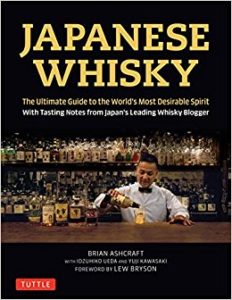Book Review: Japanese Whisky
By Richard Thomas

Japanese Whisky is a hot ticket item nowadays, enjoying a massive international interest while remaining firmly ensconced in the larger world whisky boom. Although the Japanese Whisky industry is first and foremost about its own home market, a major part of its success has been establishing itself as a peer (in quality, not quantity) with Scottish and American whiskeys. Still, all of this happened not too long ago, and even many aficionados aren’t as well-versed with the distilleries of Hokkaido as they are, say, Aberdeenshire.
Thankfully, there are plenty of books about Japanese Whisky around, but there is a catch with most of those tomes. As a rule, Japanese Whisky books (in English, at any rate) are written by Scotch writers. Fellows like Dominic Roskrow and Dave Broom have certainly been to Japan many times, know the places, players and stats as well as anyone. They can very ably tell you about Japanese Whisky as it fits into world whisky, but not so much as a thing in and of itself, as a thing that is part of Japan.
That is the main strength of Brian Ashcraft’s Japanese Whisky. Although Ashcraft isn’t an august whisky figure, he is a Texas transplant and Japan is now his home. Explaining niche aspects of Japanese culture to Westerners is his shtick, as past books on tattoos, arcades and teen-girl culture demonstrate.
So Japanese Whisky does what any competent whisky book would do with this subject. You will read about the post-World War One start of the Japanese Whisky industry and how Masataka Taketsuru was instrumental in getting both of that industry’s current giants, Suntory and Nikka, off the ground. The book deftly explores how Japanese Whisky modeled itself on Scotch, but from the beginning became a quite distinctive style, with almost as much differing from the Scotch model as it has in common. Descriptions of each of Japan’s current distilleries and their major products, and what makes them distinctive from each other, will serve as a valuable primer and get the Japanese Whisky novice up to speed.
That is the sort of thing one can find in any well-done book about Japanese Whisky, though. What Ashcraft brings to the table is placing all of this amid it’s natural context. Although he isn’t the first writer to discuss how Japanese whisky-making draws on the native traditions of Sake and the lesser known Shochu, he brings the grounding of a long term expat to matter. Likewise, he brings valuable insight on flavors that can only come from someone who dines on local soups, noodles and greasy Japanese-style pub grub every day into why Japanese Whisky is crafted the way that it is or why highball culture came into being.
I’ve read other books about Japanese Whisky that are far more in depth about the facts of the history or the technical aspects of the production, but the thing those books are missing is the broader culture. The Japanese deserve their reputation for inscrutability, and even in countries that aren’t quite so hard to come to grips with from afar, the difference between frequently visiting a place and actually living there is huge. Ashcraft infuses the standard details with that color, putting the industry in its proper context.
If you are taking a serious interest in Japanese Whisky, there are a handful of books that should serve as your primary reference on the subject. One of those should be your first read on the subject, and then you should put Brian Ashcraft’s Japanese Whisky right next to it.



